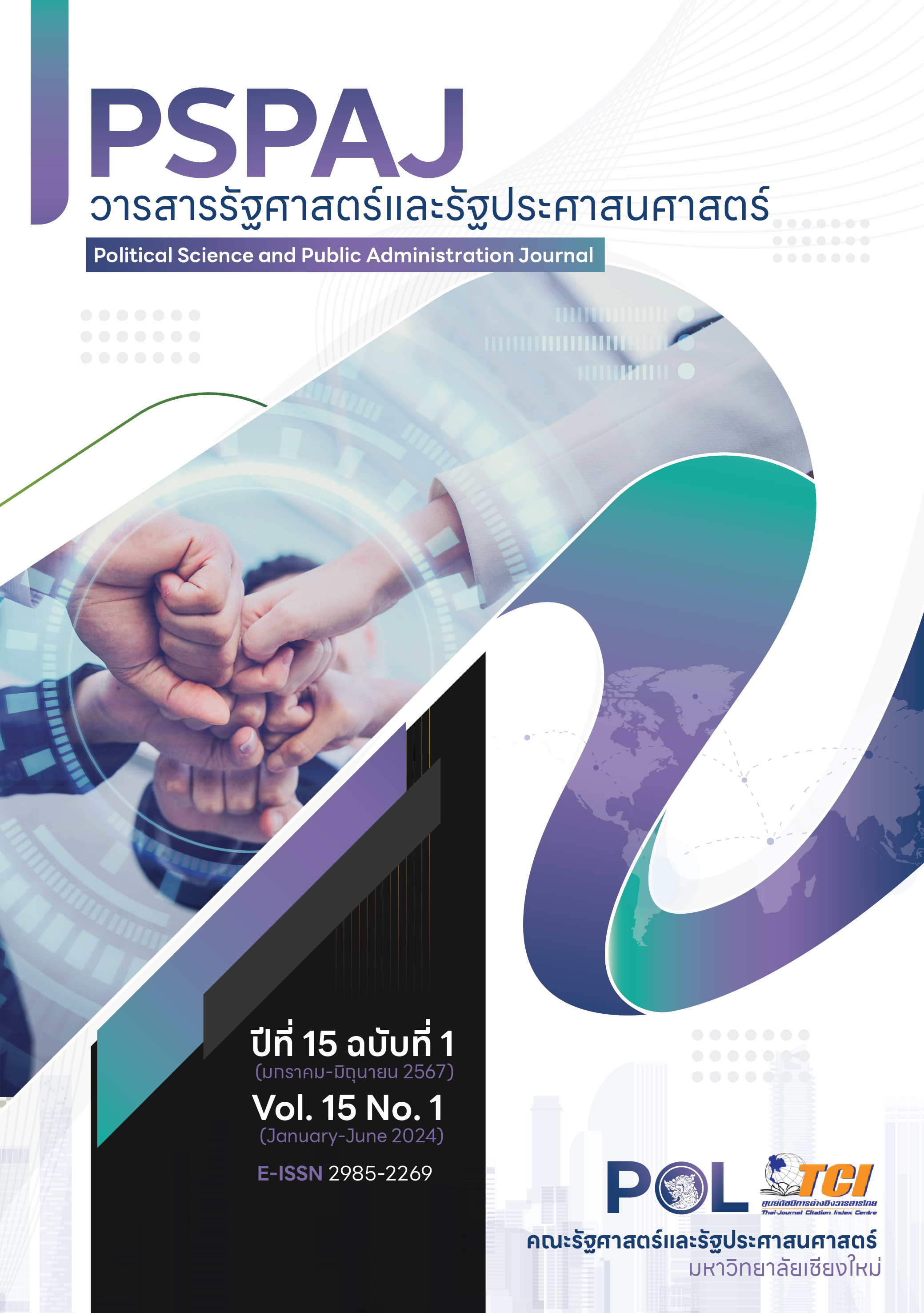แนวทางขจัดอุปสรรคและยกระดับความร่วมมือเพื่อขับเคลื่อนการพัฒนาจังหวัดบึงกาฬแบบบูรณาการ
Main Article Content
บทคัดย่อ
การประสานความร่วมมือได้กลายมาเป็นองค์ประกอบสำคัญของการบริหารกิจการสาธารณะในยุคปัจจุบัน นำมาสู่ความสนใจของการศึกษาวิจัยชิ้นนี้ซึ่งมุ่งวิเคราะห์ปัจจัยที่เป็นอุปสรรคต่อการทำงานร่วมกันระหว่างภาครัฐกับภาคส่วนอื่นๆ ในจังหวัดบึงกาฬและวิเคราะห์แนวทางยกระดับความร่วมมือเพื่อขับเคลื่อนการพัฒนาจังหวัดแบบบูรณาการของสำนักงานจังหวัดบึงกาฬ โดยใช้วิธีวิจัยแบบผสมระหว่างเชิงปริมาณและเชิงคุณภาพ มีกลุ่มตัวอย่างทั้งหมด 78 คน แบ่งเป็น 2 กลุ่ม ได้แก่ กลุ่มผู้บริหารภาครัฐและผู้บริหารภาคเอกชน 38 คน และกลุ่มประชาชนใน 8 อำเภอ ครอบคลุมทั้งจังหวัดบึงกาฬรวม 40 คน โดยใช้ Microsoft Excel ในการวิเคราะห์ข้อมูลเชิงปริมาณและใช้ Atlas.ti ในการวิเคราะห์ข้อมูลเชิงคุณภาพ ผลการศึกษาพบว่าระดับของการทำงานร่วมกันระหว่างภาครัฐ เอกชน และประชาชนในบึงกาฬอยู่ในระดับปานกลาง โดยความร่วมมือระหว่างหน่วยงานราชการด้วยกันเองมีความเป็นหนึ่งเดียวกันสูง แต่ความร่วมมือระหว่างประชาชนกับราชการอยู่ในระดับปานกลาง และความร่วมมือระหว่างเอกชนกับราชการอยู่ในระดับที่ต่ำ อีกทั้งบทความชิ้นนี้ยังพบปัจจัยที่เป็นอุปสรรคสำคัญต่อการทำงานร่วมกันในจังหวัดบึงกาฬ ประกอบด้วย 9 ปัจจัยหลัก ได้แก่ ขาดการส่งเสริมจากภาครัฐ ประชาชนในจังหวัดยังตื่นตัวน้อย ความเห็นต่างทางการเมืองขาดตัวกลางในการเชื่อมโยงความร่วมมือ ความตระหนักรู้ของประชาชน สถานภาพทางเศรษฐกิจของประชาชน แรงงานไปทำงานต่างถิ่น การสื่อสารที่ไม่มีประสิทธิภาพ และปัญหาด้านการเปลี่ยนแปลงโยกย้ายตำแหน่งงานของข้าราชการ ตลอดจนงานวิจัยนี้ยังได้วิเคราะห์แนวทางเพื่อยกระดับความร่วมมือในบึงกาฬออกเป็น 4 ด้าน ได้แก่ การพัฒนากลไกกลางเพื่อประสานความร่วมมือโดยเฉพาะ การประยุกต์ใช้เทคโนโลยีเพื่อส่งเสริมการมีส่วนร่วมอย่างครอบคลุม การส่งเสริมให้ภาคเอกชนและประชาชนตระหนักถึงความสำคัญของการทำงานร่วมกัน และนโยบายที่เน้นการสร้างอาชีพและรายได้ให้กับประชาชน
Article Details

อนุญาตภายใต้เงื่อนไข Creative Commons Attribution-NonCommercial-NoDerivatives 4.0 International License.
- เนื้อหาและข้อมูลที่ลงตีพิมพ์ในวารสารรัฐศาสตร์และรัฐประศาสนศาสตร์ถือเป็นข้อคิดเห็นและความรับผิดชอบของผู้เขียนบทความโดยตรง ซึ่งกองบรรณาธิการวารสารรัฐศาสตร์และรัฐประศาสนศาสตร์ ไม่จำเป็นต้องเห็นด้วย หรือร่วมรับผิดชอบใดๆ
- บทความและข้อมูล ที่ได้รับการตีพิมพ์ในวารสารรัฐศาสตร์และรัฐประศาสนศาสตร์ ถือเป็นลิขสิทธิ์ของวารสาร หากบุคคลหรือหน่วยงานใดต้องการนำข้อมูลไปใช้ประโยชน์ในทางวิชาการ ขอให้อ้างอิงแหล่งที่มาด้วย
เอกสารอ้างอิง
ปาลกฤษณ์ นาคะปักษิณ. (2555). ศักยภาพและความพร้อมด้านการจัดการทรัพยากรการท่องเที่ยวของจังหวัดบึงกาฬ (วิทยานิพนธ์ปริญญารัฐประศาสนศาสตรมหาบัณฑิต), มหาวิทยาลัยขอนแก่น.
ปุ่น เที่ยงบูรณธรรม, ศุภวัฒนากร วงศ์ธนวสุ, ฐานปนา บุญยประวิตร, สุรเดช ทวีแสงสกุลไทย, และสุริยานนท์ พลสิม. (2563). กิจการพัฒนาเมืองของไทย: ความคิด ความหวัง และความพยายาม. กรุงเทพฯ: สำนักงานส่งเสริมวิทยาศาสตร์ วิจัย และนวัตกรรม.
โพธิ์คิน ขวาอุ่นหล้า, และปัทมา จรูญโรจน์ ณ อยุธยา. (2563). การมีส่วนร่วมทางการเมืองของประชาชนในจังหวัดบึงกาฬ. วารสารวิชาการมหาวิทยาลัยปทุมธานี, 12(2), 354-367.
ภาภรณ์ เรืองวิชา ศุภวัฒนากร วงศ์ธนวสุ, และสุริยานนท์ พลสิม. (2564). การพัฒนาเมืองอัจฉริยะ: บทเรียนจากต่างแดนสู่ข้อเสนอแนะต่อประเทศไทย. วารสารการบริหารนิติบุคคลและนวัตกรรมท้องถิ่น, 6(4), 165-180.
ภูมิพัฒน์ พลราช. (2556). การมีส่วนร่วมของประชาชนในการอนุรักษ์พื้นที่ชุ่มน้ำกุดทิง จังหวัดบึงกาฬ (วิทยานิพนธ์วิทยาศาสตรมหาบัณฑิต), สถาบันบัณฑิตพัฒนบริหารศาสตร์.
วีระศักดิ์ เครือเทพ. (2550). เครือข่าย: นวัตกรรมการทำงานขององค์กรปกครองส่วนท้องถิ่น. กรุงเทพฯ: สำนักงานกองทุนสนับสนุนการวิจัย.
ศุภวัฒนากร วงศ์ธนวสุ, สุรเดช ทวีแสงสกุลไทย, และสุริยานนท์ พลสิม. (2564). ขอนแก่นโมเดล (พิมพ์ครั้งที่ 3). ขอนแก่น: คลังนานาวิทยา.
สำนักข่าวอิศรา. (2559, 14 มีนาคม). เชียงใหม่โมเดล Timeline ปัจจัยความสำเร็จ ของประชาสังคมในเมือง. สืบค้นเมื่อ 11 มกราคม 2566, จาก https://www.isranews.org/content-page/item/45527-timeline_45527.html
สุริยานนท์ พลสิม. (2566ก). 1 ทศวรรษบึงกาฬ: ครบรอบ 10 ปีแห่งการพัฒนา (พิมพ์ครั้งที่ 2). บึงกาฬ: สำนักงานจังหวัดบึงกาฬ.
สุริยานนท์ พลสิม. (2566ข). ภาคีภิบาล: แนวคิดและทฤษฎีการศึกษาวิจัยในอนาคต. วารสารวิทยาการจัดการ มหาวิทยาลัยสงขลานครินทร์, 40(2), 196-218.
Ansell, C., & Gash, A. (2007). Collaborative Governance in Theory and Practice. Journal of Public Administration Research and Theory, 18(4), 543-571.
Bryson, J. M., Crosby, B. C., & Stone, M. M. (2006). The Design and Implementation of Cross-Sector Collaborations: Propositions from the Literature. Public Administration Review, 66(S1), 44-55.
Greenwood, S., Singer, L., & Willis, W. (2021). Collaborative Governance: Principles, Processes, and Practical Tools. New York: Routledge.
Hood, C. (1991). A Public Management for All Seasons? Public Administration, 69(3), 3-19.
Huxham, C. (2003). Theorizing Collaboration Practice. Public Management Review, 5(3), 401-423.
Laegreid, P. (2015). Christopher Hood, “Public Management for All Seasons?”. In Lodge, M., & Page E., C., & Balla, S. J. (Eds.). The Oxford Handbook of Classics in Public Policy and Administration (pp. 541-558). New York: Oxford University Press.
Lindseth, G., & Reitan, M. (2007). The Urban Governance of Transport and the Environment in the City of Kristiansand. Journal of Environmental Planning and Management, 50(1), 135-151.
O'Leary, R. (2015). From Silos to Networks: Hierachy to Heterachy. In Guy, M. E., & Rubin, M. N. (Eds.). Public Administration Evolving: From Foundations to the Future (pp. 84-101). New York: Routledge.
Osborne, S. P. (2010). The New Public Governance: Emerging Perspectives on the Theory and Practice of Public Governance. New York: Routledge.
Osborne, S. P. (2018). From Public Service-dominant Logic to Public Service Logic: are Public Service Organizations Capable of Co-production and Value Co-creation? Public Management Review, 20(2), 225-231.
Pholsim, S., & Inaba, Y. (2022). Roles of Policy Brokers in Collaborative Governance: Evidence from Khon Kaen and Bueng Kan Cities in Thailand. Asian Politics and Policy, 14(3), 1-14
Sorrentino, M., Sicilia, M., & Howlett, M. (2018). Understanding Co-Production as a New Public Governance Tool. Policy and Society, 37(3), 277-293.


